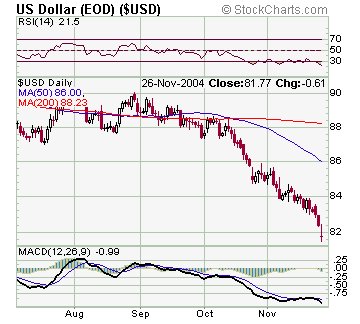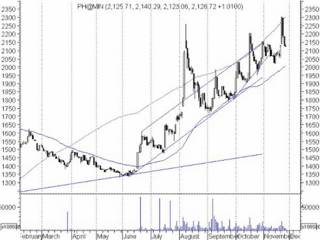The art of economics consists in looking not merely at the immediate hut at the longer effects of any act or policy; it consists in tracing the consequences of that policy not merely for one group but for all groups—Henry Hazlitt
Friday, December 03, 2004
Vincent Lam of Quam Asset Management: "Reminbi-Appreciation Is A Matter Of Time"
Thursday, December 02, 2004
Newmont Mining's Pierre Lasonde "Take Stock in Gold" published by the Resource Investor.com
By Tim Wood01
Resource Investor.com
In the 1960s we had very strong economic growth in the US and high productivity and low inflation – same thing here in the 1990s – and then it was followed by the Vietnam War. Well today we have Al Qaeda's War. In Vietnam, America was fighting over communism. Today it's fighting Islamic fundamentalism. Same difference the French will tell you! Now the only reason the French know a little bit more is because they got their head handed to them in Vietnam, and they told the Americans "don't go there!". The French also had Algeria, and they said to the Americans you know what, don't go there. Because they got their backsides kicked in Algeria as well. It's not that they really are smarter, they've just been there first.
Some people have gold conspiracies, I don't know about that. The one thing I do know is that those currencies are managed currencies and they are going to probably let them revalue against the dollar but in a very stepwise way. I tell people that one thing about China is that they do things in a Chinese way, which means that on their own time. Tight now my feeling is – and I'm sure Marc Faber is going to talk far more about it and he knows more than I will ever know – but my feeling is it's going to be a very stepwise fashion, you're going to have to wait for that.
Prudent Investor Reminisces: "The Philippine Mining Index Lags the World" Sept 25, 2003
The Philippine Mining Index Lags the World
Guest Editorial: Benson J. Te
“The country is ranked second in the world in gold reserves, third in copper, and sixth in chromite; but mining has dropped from 26% of export earnings 20 years ago to only 6% today. And not because the Philippine economy has boomed; it's been the worst in East Asia for decades. Copper production, for instance, has dropped 40% since 1981.”-Doug Casey, International Speculator
The resource rich country is an upcoming significant player in the supply dynamics of gold and other industrial metals. Despite the abundance of its natural resources, the mining industry remains moribund largely due to the depressed commodity prices that plagues the industry for more than a decade, aside from other factors such as taxes and regulation, environmental concerns, as well as other usual developing country ailments as lack of infrastructure, corruption, peace and order and political stability. However, while the government has been working hard to revive the industry, gold’s renaissance has not yet flowed into the revival of the industry itself, as evidenced by the lackadaisical movements of the prices of the mining companies, as signified by the mining index.
The market capitalization of the entire Philippine Stock Exchange is only about US$ 21.8 billion making it one of the smallest stock markets in the world. Its 30-company benchmark composite index, the Phisix, has a market capitalization of US$16.8 billion while the mining index comprising of a piddling 6 companies is capitalized at $112.5 million only. Its 2002 GDP to market capitalization (P55 to a $US) is at 29%.
Moreover, of late, the Phisix have joined the growth in global equity markets arising from the endless stream of money supplies brought about by the loosening of the monetary spigot by the world’s central banks. According to Mr. William Pesek Jr., Asian analyst for Bloomberg, “The MSCI Asia Pacific Index, a regional benchmark, is up more than 27% this year. The Thai Shares alone are up over 68% in US dollar terms. Indonesia shares are up 45%, while the Philippine Stocks are up 25%.”
Overseas investors or portfolio flows comprise a significant share of the traded volume during the latest run-up which begun during the latter portion of May of this year. Since June, despite the political stresses hounding the government, overseas investors plunked in more than $ 95 million in equity assets acquisitions; however, most of these purchases were seen in the index heavyweights, with hardly a smidgen for mining issues.
While it is understandable for money flows to be directed to emerging markets due the several factors, as enumerated by BCA Research, such as rapidly improving economic fundamentals, short-term interest rates below dividend yields, cheap currency, stimulative monetary policies and inexpensive equity assets. The prospects of a continuing rise in commodity prices due to the tightening of supplies and possibly in combination with mounting demand from the rapidly expanding China and India, or from the steep fall of the US dollar, should highlight the potentials of mining and resource based companies in our region too.
Compared to mid-November 2001 prices, London’s second fix spot gold prices as of September 23, 2003, grew 39.63% while major mining global indices had remarkable returns as the HUI 232.64%, Australian Gold Index 186.08%, SA Gold Index 183.58%, GOX 109.27%, XAU 87.54%, while only the Canadian S&P/TSE Gold Index grew a measly 51.74% close to the Philippine Mining Index’s 33.46%.
As Dr. Marc Faber points out, “it is important to understand that the emerging economies of today are the lowest-cost producers in practically every sector of the global economy.” Since the Philippines hold one of the largest reserves of gold and other industrial metals could it be that these investors, whom have been buying into our market, have overlooked the potentials from the industry’s viewpoint?
Benson J. Te
Businessworld: High Court upholds mining law
By Ma. ELISA P. OSORIO, Reporter
'The Constitution should be read in broad life-giving strokes. It should not be used to strangulate economic growth or to serve narrow, parochial interest...Rather, it should be construed to grant the President and Congress sufficient discretion and reasonable leeway to enable them to attract foreign investment, as well as to secure for our people and our posterity the blessings of prosperity and peace.'
WELCOME NEWS
Wednesday, December 01, 2004
Marc Chandler: "World View: Dollar correction may not help deficit" published by the Financial Times
By Marc Chandler
Published: November 28 2004 22:10
The macro-economic argument seems straightforward and compelling. The US has been living beyond its means, importing much more than it has been exporting and in the process becoming the world's largest debtor. At nearly 6 per cent of gross domestic product, the current account deficit is unsustainable and the long-predicted dollar correction is upon us. A substantial decline in the dollar, so the argument goes, would boost US exports and deter imports. It may also force up US interest rates, to compensate investors for the currency risk, and reduce US appetite for imports.
Sunday, November 28, 2004
New York Times: Dollar Drops Further as Central Banks Reassess Reserves By ERIC PFANNER
By ERIC PFANNER
International Herald Tribune
LONDON, Nov. 26 - The falling dollar reached new depths against the euro today, after a weeklong erosion of value prompted by concern that the dollar's status as the premier international reserve currency is growing more precarious.
The central bank of Russia said today that it would stop trying to peg the ruble solely against the dollar, shifting instead to a target based on a basket of global currencies. That could result in a decline in dollar purchases by the Russian central bank, whose currency reserves are dominated by dollar assets.
On Tuesday, a Russian central bank official, Alexei Ulyukayev, said his bank was considering altering the mix of its reserve holdings, possibly adding more euro-denominated assets, as the dollar weakens. And today, the bank's deputy chairman, Konstantin Korishchenko, said the bank would henceforth aim to keep the ruble trading within a range determined by a basket of currencies, not just the dollar.
New York Times: "When Weakness Is a Strength" by Stephen Roach
By STEPHEN S. ROACH
Suddenly all eyes are on a weakening dollar. In recent days, the American currency has fallen against the euro, the yen and most other currencies around the world. The renminbi is a notable exception; China has kept its currency firmly pegged to the dollar for a decade.
Prudent Investor: A Compelling Buy!
With the US Dollar appearing to fall from a cliff....

Gold seems to Rise above the Din....

Which should bring the forth a momentous buying opportunity from the Philippine Mining Index which has apparently lagged behind the current developments (down below)….
Saturday, November 27, 2004
Friday, November 26, 2004
Financial Times: Dollar recovers on denial of Chinese sell-off
Shanghai-based China Business News quoted Yu Yongding, a member of the central bank’s advisory monetary policy committee, as “revealing” that the rate of increase of holdings of US government bonds had fallen and total holdings were currently around $180bn.
Reuters: Gold Eyes New Highs
Traders were also watching for possible intervention by the Bank of Japan, which is worried about dollar-yen levels.
Thursday, November 25, 2004
Buttonwood of the Economist: The dollar’s demise
Nov 23rd 2004
From The Economist Global Agenda
Tuesday, November 23, 2004
Financial Times: China tells US to put its house in order
Stephen King: Dollar's weakness is a concern for us all
Do trade deficits matter? There are those who argue they don't. Many American policy makers have, in the past, taken the view that America's trade deficit is a sign of strength, not of weakness. For them, the trade deficit is an inevitable consequence of America's attractions as a home for international capital. The more that foreigners wish to accumulate US assets, the more that imports into the US will rise. If, for example, a Japanese car company decides to build a factory in the US, the required machines and equipment could be imported into the States from all over the world. US imports would rise, but only because everyone wants to invest there rather than elsewhere. That's good for American jobs, good for American incomes, and good for America in total.
stephen.king@hsbcib.com
Philippine Star: $3.2B in mining investments seen in next 5 years
By Marianne V. Go
According to Purisima, these mining projects would result in employment for 6,000 workers and create 36,000 indirect jobs.
Saturday, November 20, 2004
Japan Times: Japan, Philippines clear steel hurdle, reach FTA accord
Japan, Philippines clear steel hurdle, reach FTA accord
Economy, Trade and Industry Minister Shoichi Nakagawa and Philippine Secretary of Trade and Industry Cesar Purisima reached the agreement on the sidelines of a two-day ministerial meeting of the Asia-Pacific Economic Cooperation forum in
The deal with the
The agreement with the
Nakagawa said the two nations reached a compromise on the
Nakagawa said tariffs on Philippine-bound Japanese steel exports definitely will be lowered with the agreement, and the two countries will fine-tune the details at working-level negotiations.
"With a basic agreement reached, negotiations at the political level are over," he said.
The agreement was reached after Purisima consulted President Gloria Macapagal Arroyo on the matter, according to Nakagawa.
The pact will probably be endorsed at a meeting between Prime Minister Junichiro Koizumi and Arroyo on the sidelines of the summit of the Association of Southeast Asian Nations plus three --
The issue of accepting foreign workers in
On agricultural products,
The

